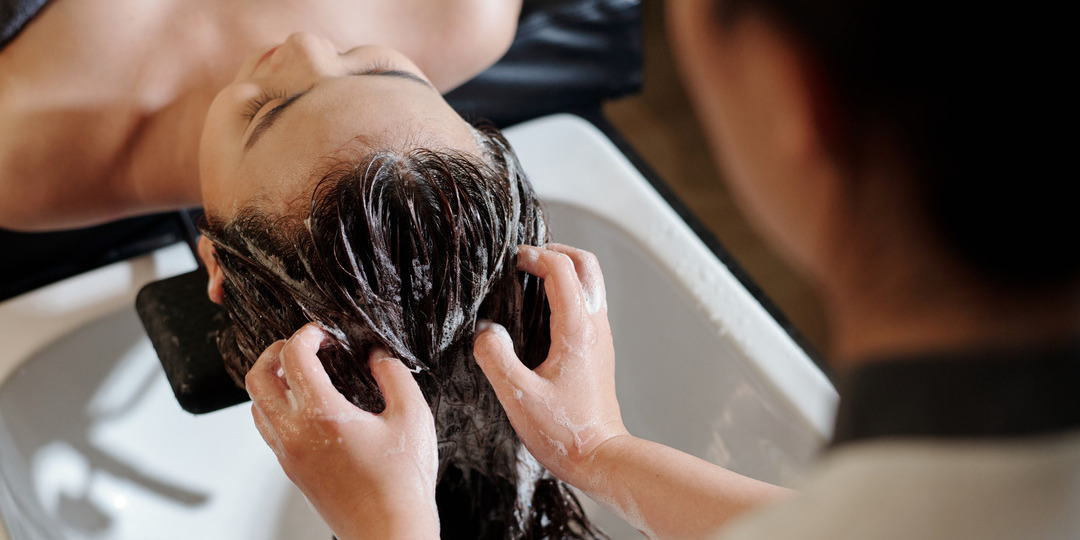
Wondering what high porosity hair is? Porosity is the ability of hair to soak in or retain moisture. High porosity hair is when hair readily absorbs oils, butter, or products but doesn’t retain them longer.
In other words, it absorbs moisture quickly but loses it just as fast! Let’s understand more about high-porosity hair and how to care for it using DIY hair masks, shall we?
Understanding High Porosity Hair

As mentioned earlier, hair porosity explains how much moisture hair can take in and retain. According to this ability, hair is classified into high-porosity hair, medium-porosity hair, and low-porosity hair.
Determining what type your hair falls under is crucial so you can care for it accordingly. Here, we are discussing caring for high-porosity hair.
Hair is highly porous when it soaks up moisture quickly but loses it equally quickly. The cuticle is the outermost layer of the hair.
Generally, highly porous hair is because the hair cuticles are too far from each other, which means they absorb moisture readily and lose it quickly. In other words, highly porous hair tends to lose moisture very fast.
This means dry hair is a common problem, along with other related issues like frizzy hair, breakage, lack of shine, tangles, bad hair days, damaged hair, dry scalp, etc. Caring for high-porosity hair involves restoring damaged hair to health and moisture retention.
It is essential to nourish hair follicles, moisturize hair shafts and seal moisture, nourish and strengthen hair strands, etc. This can be done using DIY hair masks with heavy and nourishing ingredients, like oils and butter.
Benefits of DIY Hair Masks for High Porosity Hair
High porosity hair could be due to hereditary reasons, or it could also be due to hair styling and processing treatments like bleaching, straightening, blow drying, and other chemical treatments. Regardless of the reason, it’s possible to nurture and restore hair health using DIY hair masks for high-porosity hair.
All our hair mask recipes include natural ingredients. This means they’re free from chemicals or other harsh ingredients.
We use ingredients usually available in most homes, like coconut oil. The items are either already available or accessible to procure.
These DIY hair masks for high-porosity hair cost a fraction of the cost we might have to pay should we opt for commercial hair masks. Our homemade hair mask recipes use natural oils, butter, proteins, and other ingredients to nurture and nourish high-porosity hair and restore it to health and vitality.
These homemade hair masks help nourish, moisturize, strengthen, and rejuvenate your hair and, most importantly, retain moisture by sealing hair cuticles.
5 DIY Hair Mask Recipes
Now that we’ve covered the basics, it’s time we look into the DIY hair masks for high-porosity hair and how to use them.
DIY Avocado & Banana Hair Mask for Dry Hair
Is your hair dry, dehydrated, and frizzy? Has your hair lost luster and shine?
Try this easy hair mask to moisturize your locks and restore lost moisture and shine. Rich in vitamins and minerals, this hair mask also supplies nutrients to your hair strands and strengthens your hair follicles.
Ingredients
Avocado – 1
Banana – 1
Yogurt – 1 Cup
Olive Oil – 1 Tbsp.
Instructions
Scoop out the flesh from the avocado and add it to your blender.
Chop the bananas and add them along with the avocado.
Run it in your blender for a few seconds to get a smooth paste.
Transfer to a mixing bowl and add olive oil and yogurt to it.
Stir to combine.
Usage
Apply the hair mask on your hair from the roots to the tips.
Cover your head with a shower cap and let it sit for 30 minutes.
Shampoo, condition, and air dry your hair.
Style as usual.
If you notice any residue after rinsing off, use a shampoo comb to remove them.
Notes
You can also add argan oil instead of olive oil for this hair mask.
You can apply this mask to dry hair or damp hair.
Finish off with a clarifying rinse like apple cider vinegar to restore the scalp’s pH levels and shiny locks.
You can do this twice a week.
DIY Coconut Hair Mask for Hydration
Is your hair dry? Is your scalp sensitive or inflamed? Try this soothing and moisturizing hair mask today for shiny and nourished locks.
Instructions
Coconut Oil – 1/4 Cup
Honey – 2 Tbsps.
Ingredients
Add the coconut oil and honey to a mixing bowl and heat in your double boiler.
Alternatively, you can place it in a bowl and put the bowl in a giant bowl with warm water and heat it indirectly.
Whisk to combine.
Usage
Apply the oil blend on your hair and scalp and let it sit for 30 minutes.
Rinse out, shampoo, and condition as usual.
Air dry and style as usual.
Notes
You can also use olive oil along with coconut oil in this recipe. Not only do these natural oils moisturize your hair, but they also seal in moisture by coating your strands.
You can use blue agave nectar instead of honey in this recipe for a vegan version.
Add a few coconut milk spoons to nourish and soothe your locks.
You can do this twice a week.
DIY Egg Mask for Nourishment
Protein loss is widespread with high porosity hair. This nourishing hair mask is a deep conditioner that restores lost protein and strengthens hair.
Ingredients
Egg – 1
Olive Oil – 1/4 Cup
Honey – 2 Tbsps.
Aloe Vera Gel – 1 Tbsp.
Instructions
Whisk the egg in a mixing bowl.
Add the honey, aloe vera gel, and olive oil and continue whisking until thoroughly combined.
Usage
Apply the egg mask from root to tips.
Cover your head with a shower cap and let it sit for 30 minutes.
Rinse and shampoo as usual.
Notes
You can also use Jojoba Oil in this recipe.
Use a mild shampoo, and remember to condition your hair.
You can use this hair mask once a week.
DIY Vegan Shea Butter Hair Mask
This mask also works as a deep conditioner that nourishes and moisturizes dry and thirsty locks. It not only nourishes and soothes but also strengthens weak hair.
This is ideal for high-porosity hair that’s extremely dry.
Ingredients
Shea Butter – 2 Tbsps.
Banana – 1
Blue Agave Nectar – 1 Tbsp.
Coconut Milk – 1/4 Cup
Instructions
Melt the Shea butter in your double boiler and slowly add coconut milk.
Once warm, remove from heat and add in the blue agave nectar.
Chop the banana, run it in your blender for a smooth paste, and add the remaining ingredients to the mixing bowl.
Whisk to combine thoroughly.
Usage
Apply the hair mask on your hair from the roots to the tips.
Cover with a shower cap and let it sit for 30 minutes before washing off.
Use a shampoo comb on wet hair to get rid of any residue.
Rinse, shampoo, and condition your hair.
Air dry and style as usual.
Notes
You can use a clarifying shampoo or a rinse like apple cider vinegar to restore the scalp’s pH levels and prevent scalp residue.
You can also add avocado to this recipe.
DIY Apple Cider Vinegar Hair Mask
This simple and clarifying mask gently cleanses the scalp and restores the scalp’s pH. It promotes healthier hair and scalp.
Ingredients
Apple Cider Vinegar – 1/4 Cup
Honey – 1/4 Cup
Olive Oil – 1/4 Cup
Aloe Vera Gel – 1 Tbsp.
Instructions
Add all the ingredients to a mixing bowl and whisk to combine.
Usage
Apply the prepared hair mask on your hair from root to tip.
Let it sit for a good 30 minutes before washing off.
Notes
You can do this once every two weeks.
You can alter the measurements proportionately according to your hair length.
Tips for Applying Hair Masks on High Porosity Hair
- When applying a DIY hair mask, the key is to cover all areas of your hair and scalp. For this, it’s best to divide and conquer.
- Divide your hair into smaller sections, making application and coverage easier.
- Apply the prepared DIY hair mask evenly over the hair strands from root to tip using a hair coloring brush.
- You can massage your scalp after application for a few seconds before covering your head with a shower cap.
- Wait for the recommended duration before washing off.
- Some hair mask recipes might be dense and require a little help in the form of lukewarm water, but never use hot water to wash or rinse the hair mask.
- Shampoo, condition, and air dry your hair.
- Style as usual.
- You can also use clarifying rinses occasionally to prevent scalp buildup.
- Use the homemade hair masks according to the instructions, and don’t use them more often than needed.
Common Mistakes to Avoid

The most common mistakes people make when applying homemade hair masks and how to avoid them:
- Use an old hair mask or store leftovers longer than recommended. To prevent this, always use a fresh hair mask, or if you’re using leftovers, use them within the recommended duration.
- Don’t overapply a hair mask – some masks shouldn’t be applied on the scalp roots, etc. Know your hair requirements and use the hair mask accordingly. You don’t want to apply more and weigh down your locks or undernourish them by not applying enough.
- Using a hair mask sporadically won’t give you the desired results. Use it according to the recommended frequency for best results.
- Don’t leave the hair mask on for longer or shorter than recommended.
- Choose ingredients after identifying your hair type and requirements for the best results.
- Not doing a patch test is another common mistake many make when using homemade hair masks. Some ingredients can cause severe allergic reactions. You may or may not know what you’re allergic to. So, always do a patch test to check for allergies or sensitivity.
Bottom Line
High porosity hair is typical and can be nurtured and cared for using hair masks and making lifestyle changes. Try these DIY hair mask recipes for your hair, and let us know how they work out for you.
Don’t have time for DIY? We’ve got your back with a range of premium vegan hair care cosmetics from Vitamins Revive. Check out their online store to learn more about their products.
Please contact us with any questions, doubts, feedback, or requests. We love hearing from you all and knowing how our recipes work out for you.
So, share your experience, any tweaks you made, and the results. All DIY recipes take time, but they work without an underlying issue.
So give it a fair time and then consult a specialist if your problem persists.









